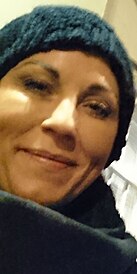
Soho is an area of the City of Westminster, part of the West End of London. Originally a fashionable district for the aristocracy, it has been one of the main entertainment districts in the capital since the 19th century.

The steelpan is a musical instrument originating from Trinidad and Tobago. Steelpan musicians are called pannists.

Carnaby Street is a pedestrianised shopping street in Soho in the City of Westminster, Central London. Close to Oxford Street and Regent Street, it is home to fashion and lifestyle retailers, including many independent fashion boutiques.
Samuel L. Manning was a Trinidadian performer and songwriter who was one of the earliest calypsonians to achieve international acclaim.

Karen Jane Wallace, known professionally as Jessie Wallace, is an English actress. She is known for portraying the role of Kat Slater on the BBC soap opera EastEnders. Her role as Kat won her the National Television Awards for Most Popular Newcomer (2001), as well as the British Soap Award for Best Newcomer (2001), Most Popular Actress (2003) and the British Soap Award for Best Actress (2011). She was also nominated for the 2011 BAFTA TV Award for Best Supporting Actress for her role as Pat Phoenix in the BBC Four television film The Road to Coronation Street.
People of African descent from the Caribbean have made significant contributions to British Black music for many generations.

Robert Douglas Finlayson, known professionally as Robert Douglas, was an English stage and film actor, a television director and producer.
George Browne, better known as the Young Tiger, was a Trinidadian calypso musician.
Amy Ashwood Garvey was a Jamaican Pan-Africanist activist. She was a director of the Black Star Line Steamship Corporation, and along with her former husband Marcus Garvey she founded the Negro World newspaper.
Club Eleven was a nightclub in London between 1948 and 1950 which played a significant role in the emergence of the bebop jazz movement in Britain.
Russell Audley Ferdinand "Russ" Henderson was a jazz musician on the piano and the steelpan. Originally from Trinidad and Tobago, he settled in England in the 1950s. He is most widely recognised as one of the founding figures of the Notting Hill Carnival in London, United Kingdom.

Georgie Fame and the Blue Flames were a British rhythm and blues group during the 1960s whose repertoire spanned jazz, soul, ska, and calypso.
Lloyd Coxsone is a Jamaican-born sound system operator and record producer, who has been resident in the United Kingdom since 1962.

The Flamingo Club was a jazz nightclub in Soho, London, between 1952 and 1969. It was located at 33–37 Wardour Street from 1957 onwards and played an important role in the development of British rhythm and blues and modern jazz. During the 1960s, the Flamingo was one of the first clubs to employ fully amplified stage sound and used sound systems provided by ska musicians from the Caribbean. The club had a wide social appeal and was a favourite haunt for musicians, including The Who.
Wilbert Augustus Campbell, known as Count Suckle, was a Jamaica-born sound system operator and club owner who was influential in the development of ska and reggae music, and African-Caribbean culture, in the United Kingdom.
Rupert Theophilus Nurse was a Trinidadian musician who was influential in developing jazz and Caribbean music in Britain, particularly in the 1950s.

Ganton Street is a street in central London that runs between Marshall Street and Kingly Street. It is crossed by Carnaby Street, and Newburgh Street joins it on its north side. The street is in a part-pedestrianised area dominated by independent clothing shops and restaurants, and on upper floors, offices, particularly media companies. Immediately to the east of Regent Street, Ganton Street is variously described as being in the West End, Soho, and "Carnaby" areas.
Margaret Cook was a woman who was shot dead on 9 November 1946 outside the Blue Lagoon nightclub in Carnaby Street, London. In 2015 a man living in Canada confessed to the shooting which would make this the longest gap between a crime and a confession in British criminal history.










